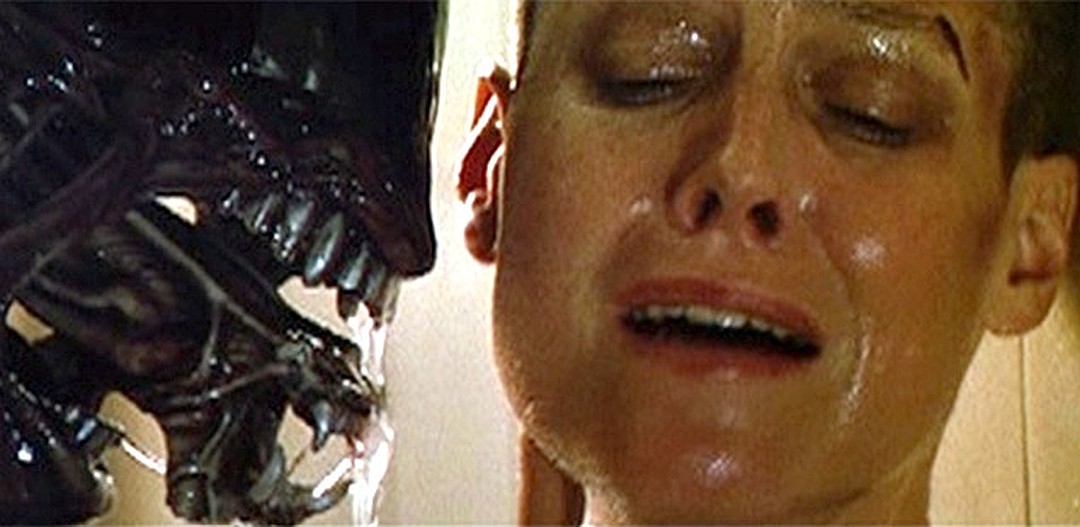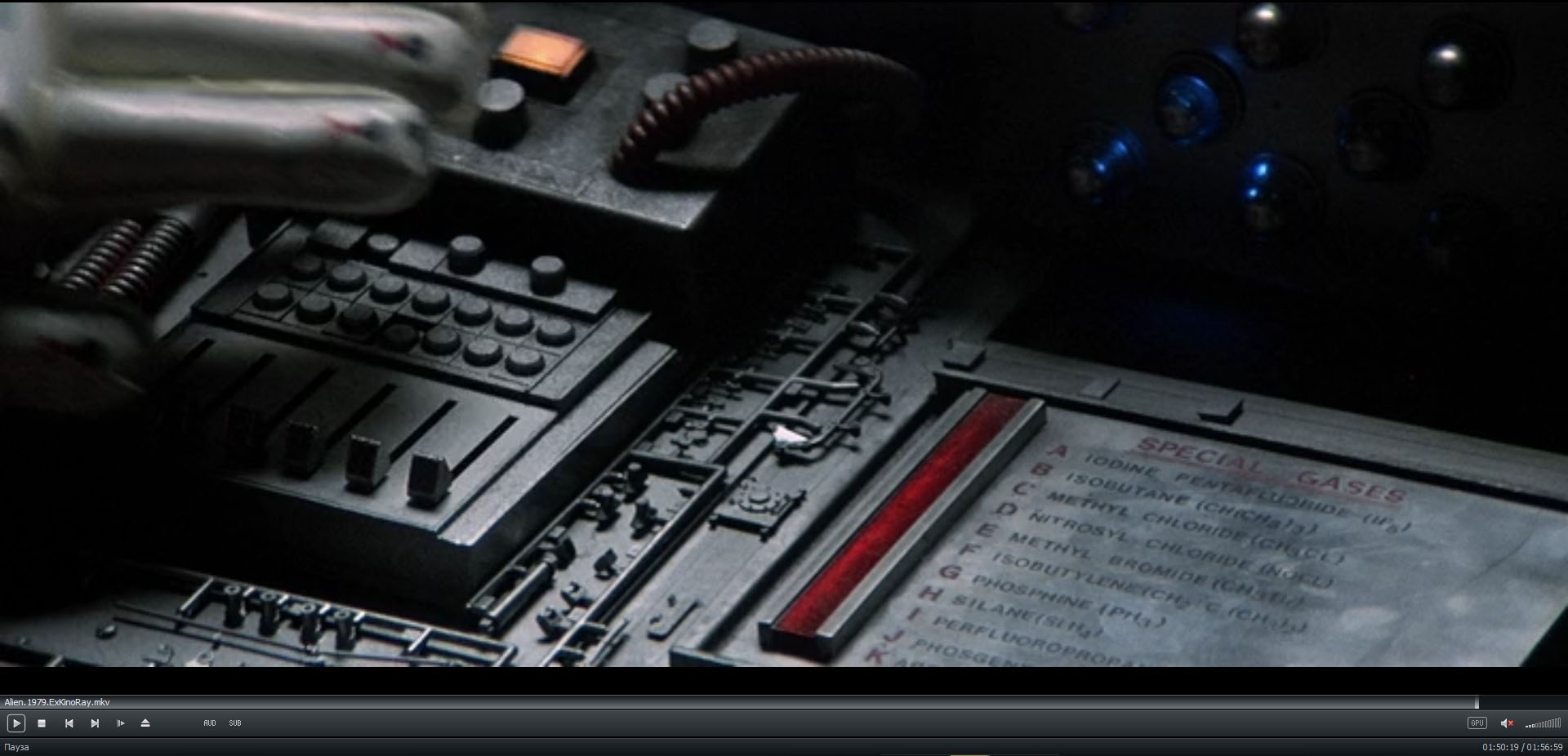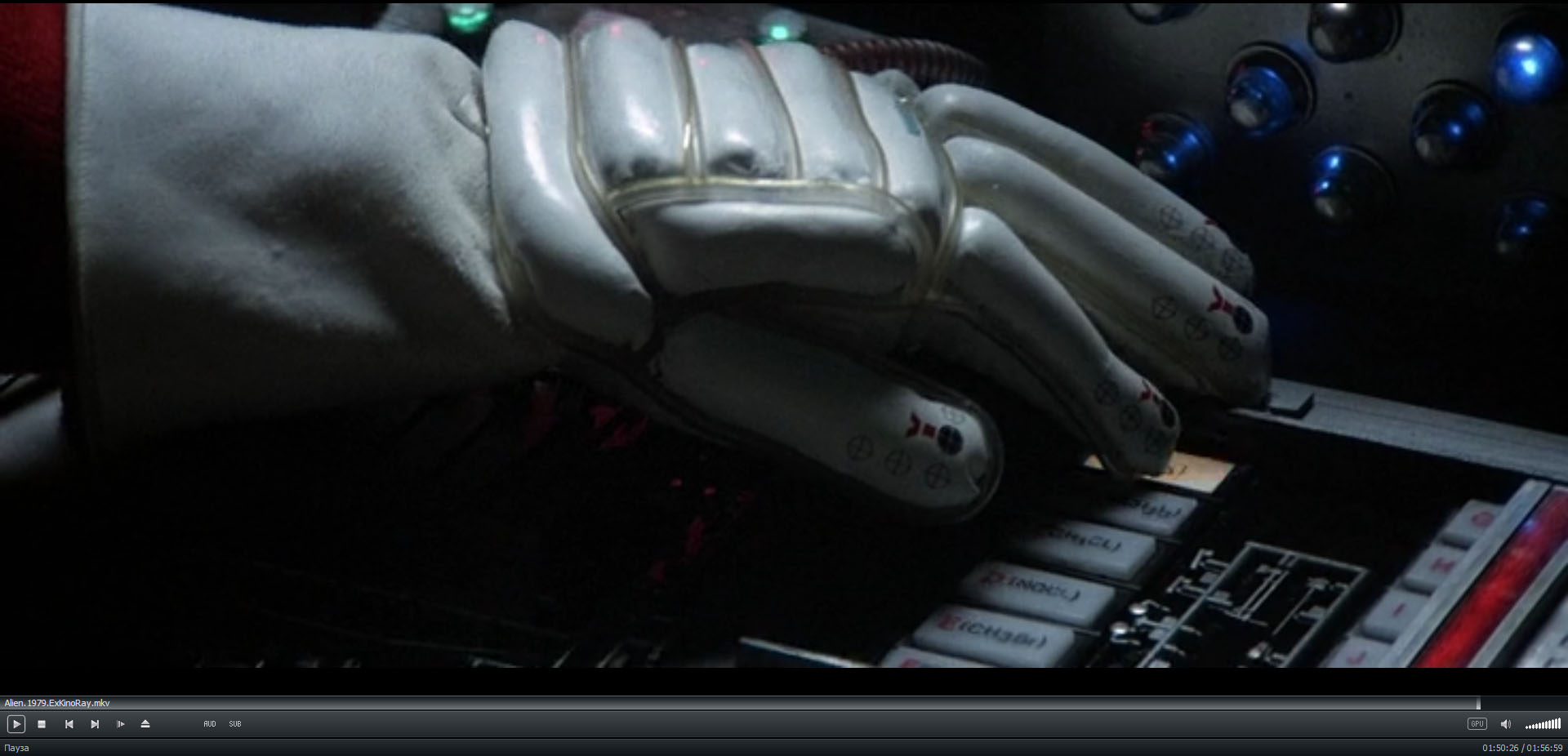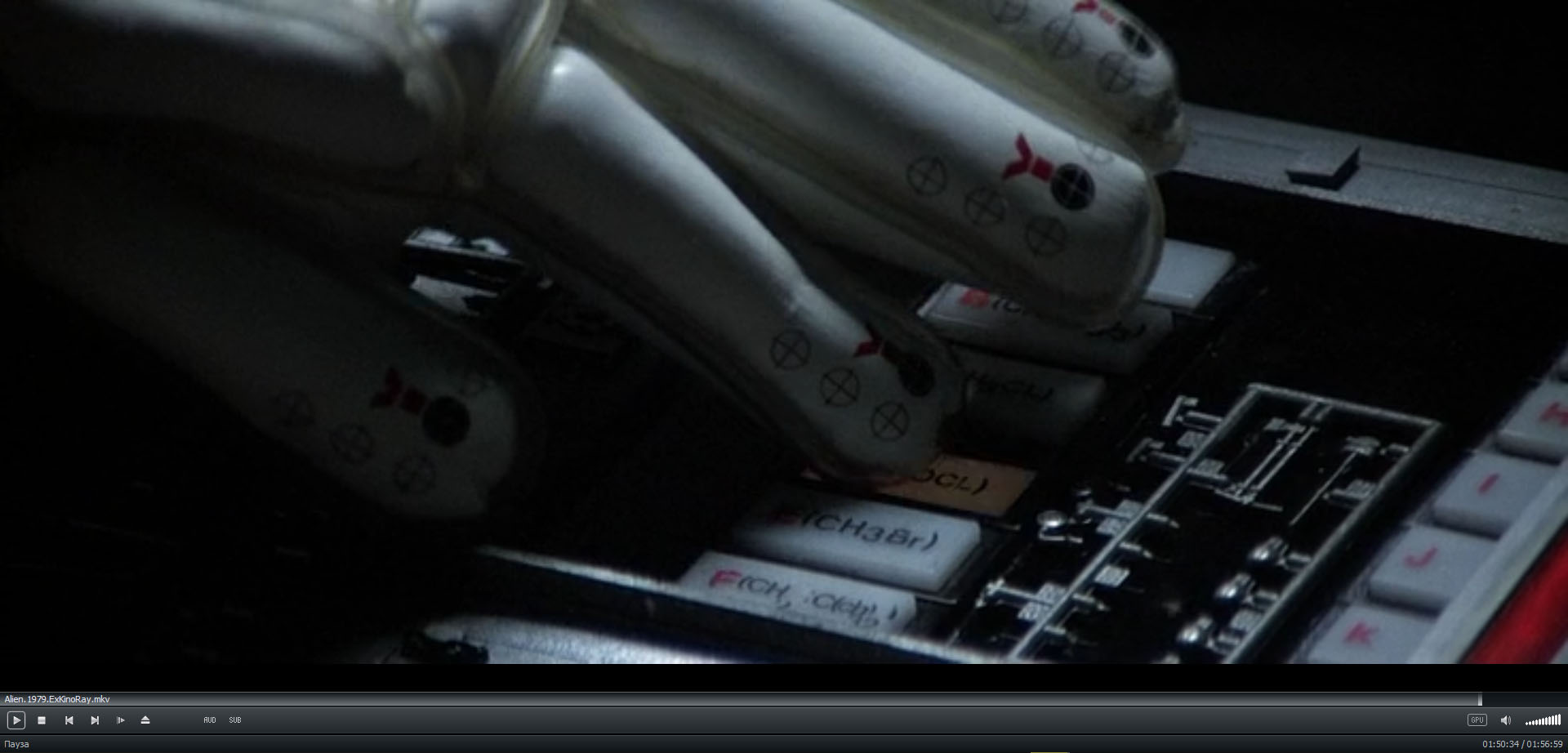We disassemble the ending of "Alien"

Hi,% username%.
I, as usual, will not calm down.
')
And the reason for all pentafluoride iodine and the last article !
In general, we all (hopefully) remember the beginning of Ridley Scott's work and the simply stunning film “Alien,” which I recommend, despite the fact that he is 1979. By the end of this article I will prove that the film is not just cool - it is SCIENTIFIED!
And for this we will strain the memory and recall the ending: Ripley sits on the canoe and suddenly finds the Alien there.
And now there will be some pictures, warm memories and chemistry.
Having found the Alien, Ripley decides to blow on him with special gases. Wearing a spacesuit cheerfully (and for good reason, as will be shown later - and it's not even in space), while singing a song about
Special gases on the shuttle

The list is more than curious:
- A. Pentafluoride iodine.
- V. Isobutan.
- C. Methyl chloride.
- D. nitrosyl chloride.
- E. Methyl bromide.
- F. Isobutylene.
- G. Phosphine.
- N. Silan.
- I. Perfluoropropane.
- J. Phosgene.
- K. Something on "A", argon, acetylene, arsine? I do not know, I can not make out.
So, Ripley is trying to fumigate our friend first with iodine pentafluoride:
First try

Someone else celebrates these actions a little.
Then - fumigated with methyl chloride.
Second try

Also zero to ground.
From the third time - good luck! We fumigate the creature with nitrosyl chloride.
Third attempt

And here went twisting and throwing

It all ended by throwing out into space and burning in the exhaust from the engine.
By the way, the Alien in the exhaust is not burned, which is important

And now let's sort it out.
What kind of gases?
"Special gases on the canoe" is really a strange set.
1. Pentafluoride iodine IF 5
Well, actually, iodine pentafluoride is not a gas, but a heavy yellow liquid with a boiling point of 97.85 ° C. I already wrote about him , this is a very strong fluorinating agent, that is, if our little animal was blown over with this rubbish at boiling water temperature - it is really tenacious! Many questions are what the shuttle itself is made of, since iodine pentafluoride calmly destroys not only metals, but also glass with concrete. Also questions to the suit Ripley - but that is.
2. Isobutane CH (CH 3 ) 3
Isobutane - a common combustible gas (by the way, with an octane rating of 100), can be used in internal combustion engines and as a refrigerant. Ripley did not use it - and correctly: if iodine pentafluoride did not give a result, was it? Especially since there could be sparks there later - and therefore, it could have jerked.
3. Methyl chloride CH 3 Cl
Methyl chloride is a colorless, poisonous gas with a sweetish odor. Due to low odor, toxic or explosive concentrations are easily overlooked. Chloromethane was previously also used as a refrigerant, but due to toxicity and explosion hazards it is no longer found in this role. The main application now: the production of polymers, as a methylating agent in organic synthesis, as rocket fuel, as a carrier in low-temperature polymerization, as a liquid for thermometric and thermostatic equipment, as a herbicide (also limited due to toxicity).
The toxicity of methyl chloride is associated with its hydrolysis to methyl alcohol - well, then, as I wrote in one of the previous articles .
Ripley either did not know biochemistry, or hoped that the Alien also had alcohol dehydrogenase in the body
4. Nitrosyl chloride NOCl
Nitrosyl chloride is a red gas, toxic, with a suffocating odor. It is usually observed as a product of the process of decomposition of aqua regia — a mixture of hydrochloric and nitric acids — it is them that stinks and its tail rises above it when heated (steamed with nitrogen oxides). I also wrote about it.
Nitrosyl chloride is widely used as a chlorinating agent, by the way it is registered as a food additive with the E919 index - as an improver and stabilizer of the color of bakery products. Sometimes it was also used to clean and disinfect drinking water.
In the food industry, nitrosyl chloride is used very little, at the same time, in its pure form, this substance represents the most serious danger to life and health. Inhalation of its vapors causes severe irritation of the mucous membranes, pulmonary edema, bronchospasm, asthma attack, as well as a number of other manifestations of respiratory disorders. Physical contact leads to chemical burns of the skin.
It is not surprising that the Alien did not like him very much.
5. Methyl bromide CH 3 Br
By nature resembles methyl chloride. Additionally, except as used in orgsintez, it is used as a fumigant for disinfecting plant materials from scale insects, false guards and mealybugs, as well as for controlling pests of stocks, in particular, fresh and dried vegetables and fruits, less often - for grain processing. As a fumigant, it is prohibited to use because of its toxicity in accordance with the Montreal Protocol.
It was also used in the processing of second-hand clothes, but even here, because of the toxicity, it was abandoned (so you can safely go to SecondHand).
Ripley was absolutely right that she didn’t use it - was it to sense if methyl chloride didn't help?
6. Isobutylene CH 2 C (CH 3 ) 2
Combustible gas, most often used in the production of polymers. Nothing special, the effect will be like from isobutane.
7. Phosphine PH 3
Poisonous gas, violates the metabolism and affects the central nervous system, also acts on the blood vessels, respiratory organs, liver, kidneys. It was considered as a chemical poisonous substance - and by the way one of the toxic products of the interaction of yellow phosphorus with water (again referring to one of the previous articles ). Clean gas - odorless, technical contains impurities, because of which has the smell of rotten fish.
Phosphine is used in the synthesis of organophosphorus, as a source of phosphoric impurities in the production of semiconductors, and also as a fumigant - an alternative to the forbidden methyl bromide. Apparently, by analogy with methyl bromide and methyl chloride, Ripley decided that phosphine would not help.
8. Silane, more precisely, monosilane SiH 4
(By the way, I thought right away SiCl 2 - but this compound is stable only at the temperature of liquid nitrogen).
Colorless gas with an unpleasant smell. It must be said that in the presence of oxygen, monosilane can ignite spontaneously. They write that silane is toxic with LC 50 0.96% for rats - if they were lucky not to burn from a silane flash.
Used in various reactions of organic synthesis (obtaining silicone polymers, etc.), as a source of pure silicon for the microelectronic industry in the manufacture of crystalline and thin-film photovoltaics based on silicon, LCD screens, substrates and technological layers of integrated circuits, as well as to obtain ultra-pure polysilicon.
I think Ripley was really afraid of the fire, and therefore did not use silane on the Alien.
9. Perfluoropropane C 3 F 8
Perfluoropropane is a typical representative of perfluorinated hydrocarbons. It can be used as a refrigerant. Slow-burning, inexplicable, low toxic. Like all perfluorocarbons, it can create a strong greenhouse effect hundreds of times stronger than CO 2 , which can potentially be used for terraforming. By the way, does not affect the ozone layer.
Ripley apparently decided that there would be no sense from perfluoropropane, it is suitable only for strangling animals that breathe oxygen - but considering how the Alien jerked cheerfully in space is not an option.
10. Phosgene OCl 2
A good choice of poison for humans and mammals - I already wrote about it , too . Also used in organic synthesis.
Apparently, Ripley understood that the Alien was too different from the biology of mammals, and therefore did not choose phosgene. He may have been number four after nitrosyl chloride. It is unknown here.
11. Oh? Argon?
Nothing special at all - inert gas. Does not interact with anything.
Also to no avail, as perfluoropropane.
11. Acetylene C 2 H 2 ?
Combustible gas, sometimes also used in organic syntheses. It may be rocket fuel, but a minus is difficult to liquefy. In the fight against Alien - like a dead poultice.
11. Arsin AsH 3 ?
The poison is very similar to phosphine, but also causes hemolysis of red blood cells. Yes, one of the strongest inorganic poisons - but I think that Ripley already understood that it was necessary to burn something and not poison it, and the Erythrocytes in the Alien's blood - well, except from dinner ...
By the way, arsine is also used for the semiconductor industry.
findings
- Ripley, in a stressful situation, acted prudently and deliberately: she did not allow a fire, she correctly selected gases to smoke the Alien - everything was done correctly.
- It is completely incomprehensible, what does the Alien consist of? Judging by the causality of its saliva, there is something like chlorine trifluoride in it, but then its temperature must be below +12 ° C, otherwise this substance will boil. Does he have blood from bromine fluorides (I already wrote about them)? Then from what he himself: not afraid of high and low temperatures, but has a significant coefficient of expansion during heating - recall the ending of "Alien-3", where after the molten lead it was possible to blow it up with splashing water. Silicone is not suitable - fluorides would have dissolved it. Any kind of organofluoric acid? But why did nitrosyl chloride act then? Here the filmmakers left a mystery.
- It is completely incomprehensible what the ship is made of: it is not afraid of hot iodine pentafluoride, nitrosyl chloride - but it is eaten through Alien's saliva through and through. If there are superacids in the blood of an Alien (read about them in the previous article , too), then gas resistance is strange. If in the blood of a stranger - fluoride halogens - it is strange that the ship was eaten by them, but iodine pentafluoride survived. The second mystery.
- The commercial Nostromo towing vehicle, or rather the rescue shuttle, is unexpectedly equipped with gases necessary for organic synthesis (fluoridation, methylation, polymer reactions, chlorination), gases for the treatment of crops from pests, fuel gases, refrigerants, raw materials for semiconductor production and gases for terraforming. It was expected that the astronaut with the use of high-tech survival? On the other hand, the distant future (the original version of the script spoke about 2087) ...
- "Alien" - the coolest movie. Unlike other golivudskih films - thought out even to such chemical trifles.
Source: https://habr.com/ru/post/451066/
All Articles